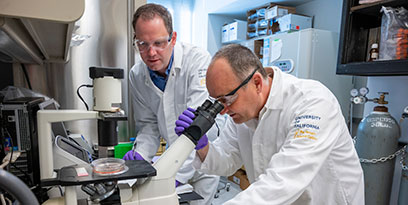Paul J. Hagerman, M.D., Ph.D.

Professor
Investigator, UC Davis MIND Institute
4455 Tupper Hall,
Davis Campus
Ph: 530-754-7266
pjhagerman@ucdavis.edu
Assistant: Lisa Makhoul
lmakhoul@ucdavis.edu
Lab Website
Research Interests
The principal objective of the Hagerman laboratory is a greater understanding of the molecular underpinnings of the fragile X family of disorders, including the neurodevelopmental disorder, fragile X syndrome, and the neurodegenerative disorder, fragile X-associated tremor/ataxia syndrome (FXTAS). Although both fragile X syndrome and FXTAS are caused by CGG-repeat expansions in the fragile X mental retardation 1 (FMR1) gene; the two disorders affect different groups of individuals, and operate through entirely different molecular genetic mechanisms. Understanding the alterations of FMR1 gene expression that lead to these two separate disorders, and the development of targeted therapies for both fragile X syndrome and FXTAS, are the fundamental objectives of the lab.
FXTAS represents the most severe form of clinical involvement associated with premutation FMR1 alleles (55-200 CGG repeats); its core features are intention tremor and/or ataxia, with peripheral neuropathy, autonomic dysfunction, and gradual cognitive decline beginning with memory and executive function deficits. Psychiatric features are often present, and may include anxiety, dysinhibition, depression, and apathy. MRI features of FXTAS include global brain atrophy, white matter disease in the subcortical, middle cerebellar peduncles (MCP) and periventricular regions.
Since our discovery of this neurodegenerative disorder in 2001, we have been involved with its characterization at the molecular, cellular, neuropathologic, and clinical levels. Based on our parallel discovery of elevated FMR1 mRNA in carriers of premutation alleles (55-200 CGG repeats), we and others have proposed that the pathogenesis of FXTAS involves “RNA toxicity” of the mRNA, by virtue of sequestration of one or more RNA binding proteins by the expanded CGG-repeat RNA.
Authored/co-authored publications on fragile X-associated tremor/ataxia syndrome (FXTAS). Click here.
Fragile X syndrome is the most common inherited form of cognitive impairment, also displaying a broad spectrum of emotional and behavioral involvement. The promoter region of full mutation forms of the FMR1 gene (> 200 CGG repeats) is generally hypermethylated and transcriptionally silent, resulting in little or no FMR1 mRNA protein (FMRP). FMRP is an mRNA transport protein and a negative regulator of translation for messages that are utilized in synaptic plasticity. Thus, fragile X syndrome is intrinsically a protein-deficiency syndrome. Fragile X syndrome is also an important genetic basis of autism, with over 50% of boys with fragile X syndrome demonstrating features of autism or autism spectrum disorders. Moreover, approximately 2 to 6% of children with autism have fragile X syndrome. The phenotype of fragile X syndrome includes hyperactivity, attention problems, anxiety, sensory integration problems leading to tactile defensiveness, unusual hand mannerisms such as hand flapping, shyness, and poor eye contact.
Our main effort is directed toward the development of targeted approaches for induction of FMRP expression in individuals with premutation or full mutation alleles of the FMR1 gene, who are producing low levels of the FMR1 protein (FMRP). Although much of this work is still in progress, strategies generally include disruption of CGG-repeat secondary structure, and of developing methods to block the effects of microRNA regulation of the FMR1 gene at the level of translation.
Authored/co-authored publications on fragile X syndrome (FXS). Click here.
Graduate Group Affiliations
All PJ Hagerman publications on PubMed. Click here.
Hagerman RJ, Hagerman PJ. Fragile X Syndrome: Lessons Learned and What New Treatment Avenues Are on the Horizon. Annu Rev Pharmacol Toxicol. 2022 Jan 6;62:365-381. doi: 10.1146/annurev-pharmtox-052120-090147. Epub 2021 Sep 9. PMID: 34499526.
Kashima R, Roy S, Ascano M, Martinez-Cerdeno V, Ariza-Torres J, Kim S, Louie J, Lu Y, Leyton P, Bloch KD, Kornberg TB, Hagerman PJ, Hagerman R, Lagna G, Hata A. Augmented noncanonical BMP type II receptor signaling mediates the synaptic abnormality of fragile X syndrome. Sci Signal. 2016 Jun 7;9(431):ra58. doi: 10.1126/scisignal.aaf6060. PMID: 27273096; PMCID: PMC5274719.
Kim K, Hessl D, Randol JL, Espinal GM, Schneider A, Protic D, Aydin EY, Hagerman RJ, Hagerman PJ. Association between IQ and FMR1 protein (FMRP) across the spectrum of CGG repeat expansions. PLoS One. 2019 Dec 31;14(12):e0226811. doi: 10.1371/journal.pone.0226811. PMID: 31891607; PMCID: PMC6938341.
Loomis EW, Eid JS, Peluso P, Yin J, Hickey L, Rank D, McCalmon S, Hagerman RJ, Tassone F, Hagerman PJ. Sequencing the unsequenceable: expanded CGG-repeat alleles of the fragile X gene. Genome Res. 2013 Jan;23(1):121-8. doi: 10.1101/gr.141705.112. Epub 2012 Oct 11. PMID: 23064752; PMCID: PMC3530672.
Loomis EW, Sanz LA, Chédin F, Hagerman PJ. Transcription-associated R-loop formation across the human FMR1 CGG-repeat region. PLoS Genet. 2014 Apr 17;10(4):e1004294. doi: 10.1371/journal.pgen.1004294. PMID: 24743386; PMCID: PMC3990486.
Robin G, López JR, Espinal GM, Hulsizer S, Hagerman PJ, Pessah IN. Calcium dysregulation and Cdk5-ATM pathway involved in a mouse model of fragile X-associated tremor/ataxia syndrome. Hum Mol Genet. 2017 Jul 15;26(14):2649-2666. doi: 10.1093/hmg/ddx148. PMID: 28444183; PMCID: PMC5886271.
Hagerman PJ, Hagerman R. Fragile X syndrome. Curr Biol. 2021 Mar 22;31(6):R273-R275. doi: 10.1016/j.cub.2021.01.043. PMID: 33756134.
Hagerman R, Hagerman P. Fragile X-associated tremor/ataxia syndrome: pathophysiology and management. Curr Opin Neurol. 2021 Aug 1;34(4):541-546. doi: 10.1097/WCO.0000000000000954. PMID: 33990099; PMCID: PMC8412174.
Holm KN, Herren AW, Taylor SL, Randol JL, Kim K, Espinal G, Martiínez-Cerdeño V, Pessah IN, Hagerman RJ, Hagerman PJ. Human Cerebral Cortex Proteome of Fragile X-Associated Tremor/Ataxia Syndrome. Front Mol Biosci. 2021 Jan 29;7:600840. doi: 10.3389/fmolb.2020.600840. Erratum in: Front Mol Biosci. 2021 May 11;8:695407. PMID: 33585555; PMCID: PMC7879451.
Ma L, Herren AW, Espinal G, Randol J, McLaughlin B, Martinez-Cerdeño V, Pessah IN, Hagerman RJ, Hagerman PJ. Composition of the Intranuclear Inclusions of Fragile X-associated Tremor/Ataxia Syndrome. Acta Neuropathol Commun. 2019 Sep 3;7(1):143. doi: 10.1186/s40478-019-0796-1. PMID: 31481131; PMCID: PMC6720097.
Undergraduate Lectures
- BIS 98: UC Davis Young Scholars Program
- BCM 192: Internship in Biological Chemistry
- BCM 199: Special Study for Advanced Undergraduates
Graduate Lectures
- BCM 299: Research
- 2013 Distinguished Professor
- 2011 UC Davis School of Medicine Research Award
- 2002 William Rosen Research Award, National Fragile X Foundation
- Stallone Fund for Autism Research
- Milheim Foundation Award for Cancer Research
- Leukemia Society of America Special Fellowship
- Leukemia Society of American Fellowship




